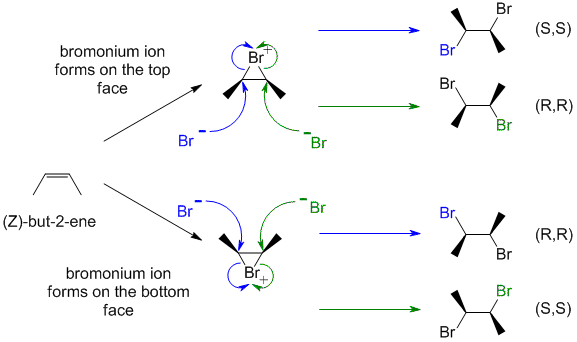| Qu1 |
|
|
(a) Propene will react to give
1,2-dibromopropane which contains 1 stereocentre at C2, therefore the product
will be a racemic mixture of (R)- and (S)-1,2-dibromopropane. |
|
|
|
(b) (E)-but-2-ene will react to
give 2,3-dibromobutane which has 2 stereocenters at C2 and C3. The reaction
is stereospecific in nature via an anti process but we should review
the possibilities. The starting point is to think of the alkene as being oriented as a horizontal plane and hence has a top and bottom face. Then the bromonium ion can form on either face. Steric effects force the bromide ion nucleophile to attack from the opposite face, but in the symmetrical case, this can occur from either end (blue pathway versus green pathway). Overall this gives four possible pathways....
Since the 2 chiral centers
in the product have the same 4 groups attached (-H, -Br, -CH3,
and -CHBrCH3), then we have a meso compound, and all 4 of theses
structures are actually the same. If you aren't convinced, rotate the
JSMOL image to look like each of them !
|
|
|
|
(c) (Z)-but-2-ene, has the same permutantions of four pathways are described above, but the outcome is slightly different. will
react to give 2,3-dibromobutane which has 2 stereocenters at C2 and C3.
Now the possibilities are:
 |
|
(S,S) |
|
(R,R) |
Since the 2 chiral centers
in the product we will get the two compounds (R,R) and (S,S) compounds
that are enantiomers so we have a racemic product mixture. If you aren't
convinced that there are only two different compounds here then rotate
the JSMOL images to look like each of them !
|
|
|
| Qu2 |
If the alkene from method A
gives a pair of enantiomers, then it must be the E-alkene. |
|
Therefore the addition of H2
must have occured with syn stereochemistry. |
|
|
|
If the alkene from method B
gives a a single meso compound, then it must be the Z-alkene.
Therefore the addition of H2 must have occured with anti
stereochemistry. |